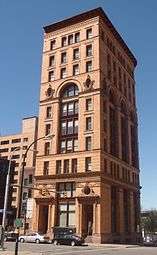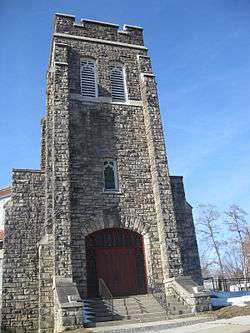Edward Brodhead Green
| Edward Brodhead Green | |
|---|---|
 | |
| Born |
May 10, 1855 Utica, NY |
| Died |
February 11, 1950 Buffalo, NY |
| Nationality | American |
| Alma mater | Cornell University |
| Occupation | Architect |
| Awards | Fellow of the American Institute of Architects (1890) |
| Practice | Green & Wicks architectural firm, Edward B. Green & Son |
Edward Brodhead Green (1855–1950), very often referred to as E. B. Green, was a major American architect from New York State.
Biography
He was born in Utica, NY. He attended Cornell University, and moved to Buffalo, NY in 1881, where he was active through about 1930. His work left a lasting impression on the city of Buffalo, and it includes such noteworthy structures as the Albright-Knox Art Gallery, Young Men's Christian Association Central Building, and Twentieth Century Club (1894); all three listed on the National Register of Historic Places. His public buildings include the Buffalo Savings Bank, Market Arcade, the Buffalo Crematory, and South Park High School, The First Presbyterian Church, Kibler High School, Tonawanda Municipal Building, and Dayton Art Institute (1930) among others. He also designed and built many private residences, including the Charles W. Goodyear Residence, the Granger Mansion, and his own residence at 180 Summer Street, which is not visible from the road. During his 72-year career, he designed more than 370 major structures. More than 160 of his Buffalo buildings survive today. Green died in Buffalo in 1950, and is buried in Forest Lawn Cemetery.
Practice
Green's best-known commissions were designed with his partner William Sydney Wicks (1854-1917), as Green & Wicks. The firm's chronology is:
- 1884: Green & Wicks founded
- 1917: Renamed E.B. Green & Son
- 1933: Renamed E. B Green after his son's death
- 1936: Renamed Green & James
- 1945: Renamed Green, James & Meadows
- 1950: Renamed James & Meadows after Green's death
- 1952: Renamed James, Meadows & Howard
- 1971: Firm dissolved
The firm's records survive in the library collections of the Buffalo History Museum.[1]
A number of their works are listed on the U.S. National Register of Historic Places.[2]
Projects
Notable works of the Green & Wicks architectural firm include:
- Albright-Knox Art Gallery
- Albright Memorial Building, N. Washington Ave. and Vine St. Scranton, PA (Green & Wicks), NRHP-listed
- American Radiator Company Factory Complex, Buffalo, NY, NRHP-listed
- Buffalo Crematorium Company, 901 W Delavan Ave, Buffalo, NY
- Birge-Horton House, 477 Delaware Ave. Buffalo, NY (Green and Wicks), NRHP-listed
- Brick Presbyterian Church, 6 Church St. Perry, NY (Green & Wicks), NRHP-listed
- Brost Building (c. 1935) in the Broadway Historic District, Lancaster, New York
- Buffalo Athletic Club
- Buffalo Savings Bank Building
- Caldwell Hall, Cornell University campus Ithaca, NY (Green & Wicks), NRHP-listed
- Charles W. Goodyear House, Buffalo, NY
- Dayton Art Institute, Dayton, Ohio
- Dun Building, 110 Pearl Street, Buffalo, NY
- D.S. Morgan building, (destroyed), Buffalo, NY
- Erie County Holding Center
- Fernow Hall, Cornell University campus Ithaca, NY (Green & Wicks), NRHP-listed
- Fidelity Trust Building, now known as "Swan Tower", 284 Main Street, Buffalo, NY
- Kibler High School, 284 Main St., Tonawanda, New York
- Marine National Bank, 1913
- Market Arcade Building, 617 Main St, Buffalo, NY
- Old West End District, Roughly bounded by Delaware, Collingwood, and Glenwood Aves. and Grove Pl. Toledo, OH (Green & Wicks), NRHP-listed
- Ransom School "Pagoda", 3575 Main Hwy. Miami, FL (Greene & Wicks), NRHP-listed
- South Park High School
- Stephen Merrell Clement House, 1913, 786 Delaware Ave, Buffalo, NY, Extant as the Red Cross Building
- St. Vincent's Female Orphan Asylum, 1313 Main St. Buffalo, NY
- University Club Building (Buffalo)
- Twentieth Century Club (Buffalo, New York)
- Watson-Curtze Mansion, 356 W. 6th St. Erie, PA (Green & Wicks), NRHP-listed
- Wing Hall, Cornell University campus Ithaca, NY (Green & Wicks), NRHP-listed
- Young Men's Christian Association Central Building, 45 W. Mohawk St. Buffalo, NY (Green & Wicks), NRHP-listed
Notable works of the E.B. Green and Sons architectural firm include:
- Abbot Hall / Lockwood Memorial Library, University at Buffalo (South Campus), 1933
- Crosby Hall, University at Buffalo (South Campus), 1931[3]
- Electric Tower, 535 Washington St. Buffalo, NY, NRHP-listed
- Michael J. Dillon Memorial United States Courthouse, 68 Court Street, Buffalo NY
- Garret Club, 91 Cleveland Ave., Buffalo, NY, 1929
Notable works of the Green & James architectural firm include:
- Buffalo Memorial Auditorium, (destroyed), Buffalo NY
- Parker Hall, University at Buffalo (South Campus), 1945
Gallery
- Swan Tower
 Dun building
Dun building Buffalo Crematorium
Buffalo Crematorium Electric Tower
Electric Tower Crosby Hall
Crosby Hall Abbot Hall
Abbot Hall Buffalo Athletic Club
Buffalo Athletic Club

 Albright-Knox Art Gallery in 1913
Albright-Knox Art Gallery in 1913

See also
References
- ↑ "Green & Wicks Bibliography". Retrieved 2010-11-19.
- ↑ National Park Service (2010-07-09). "National Register Information System". National Register of Historic Places. National Park Service.
- ↑ "Crosby Hall (CROSBY) - South Campus, Academic Sector". University at Buffalo. Retrieved 1 November 2013.
External links
- E.B. Green at www.buffaloah.com